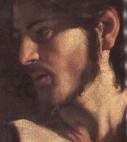“Soldiers, all men in fact are natural hero worshipers…the influence one man can have on thousands is a never ending source of wonder to me.” (General Patton)
One of the dimensions that resonates within the masculine psyche is that of the hero: the male, deep in his heart, wants to know a hero, follow a hero, and to some degree be a hero. Coined in English in the Middle Ages, the word “hero” is derived from the Greek “ἥρως” (heros), “warrior”, literally “one who safeguards”, a defender or protector. It may have the same linguistic origin as the Latin verb servo (which originally meant “to preserve whole”) and of the ancient Iranian verb haurvaiti (to keep vigil over).
As portrayed in literature the world over, the hero is the man who, leaving the everyday world, sets out upon a dangerous mission, risking even death, in order to achieve some great good. Tales of heroes are universal because the story of the hero is the story of males asserting the masculine ideal: the willingness to risk danger to the point of self-sacrifice for the sake of rescuing the female or the “feminine” ideal in need of his heroism.
Chivalric heroism powered the imagination and ethos of Íñigo de Loyola. When he made the startling discovery of this heroism in the lives of saints like Ignatius of Antioch, Francis, and Dominic new avenues for self-fulfillment outside of military ventures appeared. But the more he studied the lives of these men the more clearly he perceived through them and towering above them the person of the God-Man. Impelled by the action of the Holy Spirit in his soul, he recognized Jesus Christ as Lord, as his Lord, as the One who from then on would inspire, determine, and direct his thoughts, desires, affections and footsteps – the fascination of the Savior of mankind had gripped him in the depths of his soul.
Thus began the Basque soldier’s journey towards mystical union with the Blessed Trinity, transforming the shallow Inigo into the saint Ignatius. And, thanks to his autobiography and Spiritual Exercises the highway became known and has been travelled by countless Catholics through the past five hundred years.
The attraction that Iñigo felt toward the person of Jesus Christ was no “generic-brand” fascination. Just as friends of the same person are drawn to him or her for different reasons, each soul is provoked, intrigued, and attracted towards Jesus Christ according to the mysterious coming together of the waters of grace, temperament, and circumstances in one’s own individuality. However, there are certain characteristics of Jesus Christ that have almost universal appeal to people united by a certain age, profession, or certain qualities – and by whether they are male or female. The Basque soldier, whose ideals had been formed in the school of chivalry, discovered in the Lord Jesus Christ the archetype of masculine perfection: the hero.
This archetypal relationship between the hero and the masculine spirit is the paradigm for the relationship between Jesus Christ and the Ignatian. In closeness to the heroic Christ the Ignatian finds the pathway along which to live out his priesthood and in so doing discovers the fulfillment of his masculine psyche. This relationship with the God-Man, lived out with intensity ascetically and mystically, empowers him to find in a sublime and mystical manner what he sacrificed in marriage and physical fatherhood.
This relationship gradually takes shape in the Ignatian in three stages:
Admiration for the Hero
Following of the Hero
At-one-ment with the Hero’s Mission as Comrade-in-arms.
These stages, in their essentials, correspond to what the Apostles and all the saints experienced in their following of the Lord Jesus. St. Thomas Aquinas has outlined this ascetic and mystical journey and Thomist theologians have unfolded his explanation. See for instance Reginald Garrigou-Lagrange, The Three Ages of the Interior Life and A. Tanquerey, The Spiritual Life.

